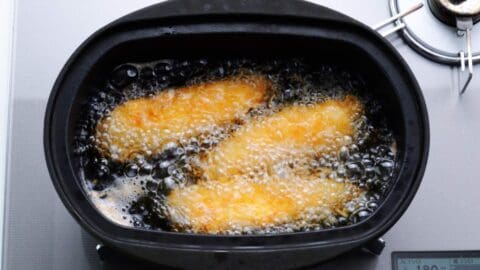Why This Recipe Works?
Marinating the breast tenders in ginger, sake, and soy sauce makes them plump and tender and infuses them with loads of extra flavor. Frying the panko tenders at a higher temperature allows you to brown the crust without overcooking the delicate breast meat. The fluffy panko breadcrumbs give the tenders a crispy texture, and the breaded shell stays crisp longer than a starch or flour coating, which makes it well-suited for packing into bento box lunches.
Ingredients
Chicken tenders - Also known as “fingers” or “tenderloins”, these are flaps of meat attached to each breast. As the name implies, they’re super tender but don’t contain much fat, which can make them a bit bland and dry. Marinating and frying them at a high temperature gives the breast plenty of flavor, allowing you to crisp up the outside without overcooking the center. You can also cut skinless chicken breasts or skinless chicken thigh into 1-inch thick strips. Sake - Sake is an alcoholic beverage frequently used in Japanese cuisine because it contains a high concentration of amino acids. The alcohol burns off when you cook the food, leaving behind the taste of umami imparted by the amino acids. Soy sauce - This is the primary seasoning for the tenders, infusing the pieces with salt and umami. I recommend using Japanese soy sauce such as Kikkoman for this. Ginger - Ginger adds a zingy flavor and contains proteolytic enzymes that make the meat even more tender. Other options for seasoning include black pepper, paprika, onion powder, or garlic powder. Flour & egg - Coating the chicken cutlets in a combination of flour and egg creates a sticky surface that makes the panko breadcrumbs stick to them. Panko - Panko means “bread crumbs” in Japanese, and it’s a unique style of breadcrumb that uses only the white part of the bread torn into small shards. Because each crumb is larger and airier than regular breadcrumbs, it creates a lighter and more crispy texture than a crust made with traditional breadcrumbs. You can purchase them already made, but you can also make them yourself using these instructions.
How to Make Crispy Panko Chicken Tenders
You first want to marinate the chicken fillets. Mix the sake, soy sauce, and ginger together, and then work the tenders into the mixture. I recommend letting this marinate in an airtight container in the fridge for at least an hour (or up to one night), but it’s best to prep this in the morning to fry up for an evening meal. When it’s time to cook the panko fried chicken, fill a deep, heavy-bottomed pot with one and a half inches of vegetable oil and heat it over medium heat to 355°F (180°C). Place a wire rack on a baking sheet and line with paper towels. Add the beaten egg mixture and panko to separate shallow bowls to set up your breading station. Drain off any excess marinade from the breast meat, and then pat it dry with paper towels. Sprinkle the flour over the dried pieces and roll them around to give them a thin, even coating. The flour and egg act as glue to hold the panko bread crumbs on, so don’t miss any spots. To panko crust your chicken pieces, use one hand to dip the flour-coated chicken in the egg wash and use the other to mound up bread crumbs onto the fillets and pat them in. This way, you avoid breading your fingers. To fry the breaded chicken pieces, carefully lower them into the oil and fry them in batches until the panko crumbs turn golden brown. This should take about three minutes, but cooking times will depend on the size of your tenders. You can use a meat thermometer to ensure the internal temperature rises above 160°Fahrenheit or 71°Celsius. You also want to make sure you flip them over once or twice so that they develop an even, beautiful golden-brown crust. Drain the panko chicken in a single layer on paper towels placed on a cooling rack to preserve their crispy crust, and serve immediately.
Serve Panko Chicken With
These juicy chicken tenders have plenty of flavor from the marinade, so they don’t really need a sauce. However, I like to squeeze a bit of fresh lemon juice on mine to accent the savory chicken flavor. You could also sprinkle them with flaky salt (like Maldon or kosher salt) or grate some Parmesan cheese on top to boost the savory taste. You could also use your favorite dipping sauce, such as ketchup, sweet chili sauce, or honey mustard. For something creamy, you could make the tartar sauce from my Chicken Nanban recipe, and Ponzu makes a refreshing sauce. In Japan, fried foods are often served with a salad made from thinly shredded cabbage, but this would be delicious with my citrusy No-Mayo Coleslaw. It would also go great with my Japanese Potato Salad or my Hawaiian Macaroni Salad. Leftovers are perfect for packing into a bento; just follow my instructions for this Chicken Teriyaki Bento and substitute in this panko chicken recipe for the teriyaki.
📖 Recipe









